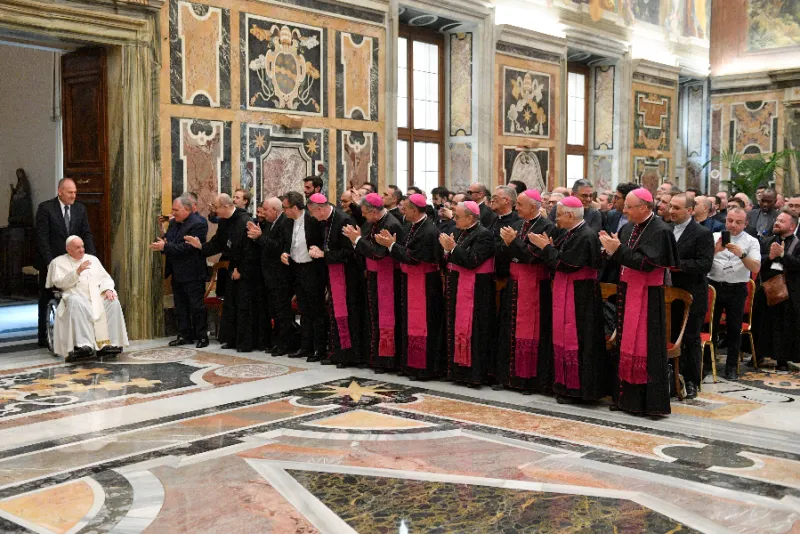
Sicilian city celebrates 400th year of feast of St. Rosalia
 Capella di Santa Rosa, St. Rosalia’s Chapel inside of the Palermo Cathedral, Basilica Cattedrale Metropolitana Primaziale della Santa Vergine Maria Assunta in Sicily, Itay. May 5, 2022. / Credit: Frank Bienewald/LightRocket via Getty Images
Capella di Santa Rosa, St. Rosalia’s Chapel inside of the Palermo Cathedral, Basilica Cattedrale Metropolitana Primaziale della Santa Vergine Maria Assunta in Sicily, Itay. May 5, 2022. / Credit: Frank Bienewald/LightRocket via Getty Images
Palermo, Italy, Jul 15, 2024 / 04:00 am (CNA).
The city of Palermo on the Italian island of Sicily is celebrating the 400th anniversary of the feast day of its beloved patron, St. Rosalia, affectionately known as “la Santuzza” in Sicilian dialect.
The July 15 feast marks when tradition holds the hermit girl’s remains were rediscovered in a cave close to Palermo in 1624. Her intercession, begged by carrying her relics in solemn procession through the Spanish-ruled city, is said to have saved its inhabitants from plague 400 years ago this summer.
“‘Per amore Domini mei,’ [‘for love of my Lord’] is the motive St. Rosalia invokes in surrendering one’s existence and abandoning the wealth of the world,” Pope Francis said in a message sent to Archbishop Corrado Lorefice of Palermo July 8.
“The life of the Christian, both in the times when our hermit Virgin lived and in our days, is constantly marked by the cross,” the pontiff said. “Christians are those who always love, but often in circumstances where love is not understood or is even rejected.”
St. Rosalia is believed to have been born around 1130 to a family of Norman origin that boasted to be descended from Charlemagne. She lived about 60 years after the Norman conquest of Palermo, which saw the city returned to Christianity after a period of Arab and Muslim rule.
Despite belonging to a noble family, Rosalia renounced her riches to live as a hermit in a cave on Mount Pellegrino, just north of the city.

According to popular belief, St. Rosalia was led to the cave by angels and wrote on the cave wall: “I, Rosalia, daughter of Sinibald, Lord of [Monte] delle Rose, and Quisquina, have taken the resolution to live in this cave for the love of my Lord, Jesus Christ.” She died in the cave, poor and alone, around 1166, while only in her mid-30s.
The groundbreaking for the construction of the Palermo cathedral began two decades later, in 1185.
But the remains of the holy young woman would not be found until over 400 years later, when, the tradition says, Rosalia appeared to a hunter, to whom she indicated where her relics could be found.
Rosalia’s remains were carried around Palermo three times in procession, as she had indicated to do in her apparition to the hunter, and a plague then ravaging the city ceased.
From that point onward, Rosalia, called “la Santuzza” (“the little saint” in English), has been the patron saint of Palermo.
The Palermo Archdiocese marks her feast day with a week of religious and cultural events leading up to the grand finale on July 15: a solemn procession of her relics through the city’s main streets followed by a fireworks show on the steps of the cathedral.
But the night prior, on July 14, the city takes part in a less devotional spectacle: a parade of colorful floats and a statue of the saint, which goes from the Palace of the Normans, a governmental building, to the coast of the Tyrrhenian Sea.
To mark the feast’s 400th anniversary, the archdiocese and city have been celebrating a Rosalian jubilee year to conclude on Rosalia’s other feast day, Sept. 4.
“The happy occurrence of the fourth centenary of the discovery of the body of St. Rosalia is a special occasion to unite myself spiritually with you, dear sons and daughters of the Church of Palermo, who wish to raise to the heavenly Father, the source of all grace, praise for the gift of such a sublime figure of a woman and ‘apostle,’ who did not hesitate to accept the trials of loneliness for love of her Lord,” Pope Francis said in his message last week.
“With Rosalia, woman of hope, I therefore exhort you: Church of Palermo stand up! Be beacons of new hope, be a living community that, regenerated by the blood of the martyrs, gives true and luminous witness to Christ our Savior,” he continued. “People of God in this blessed stretch of land, do not lose hope and do not give in to discouragement. Rediscover the joy of wonder before the embrace of a Father who calls you to himself and leads you on the paths of life to savor the fruits of harmony and peace.”


